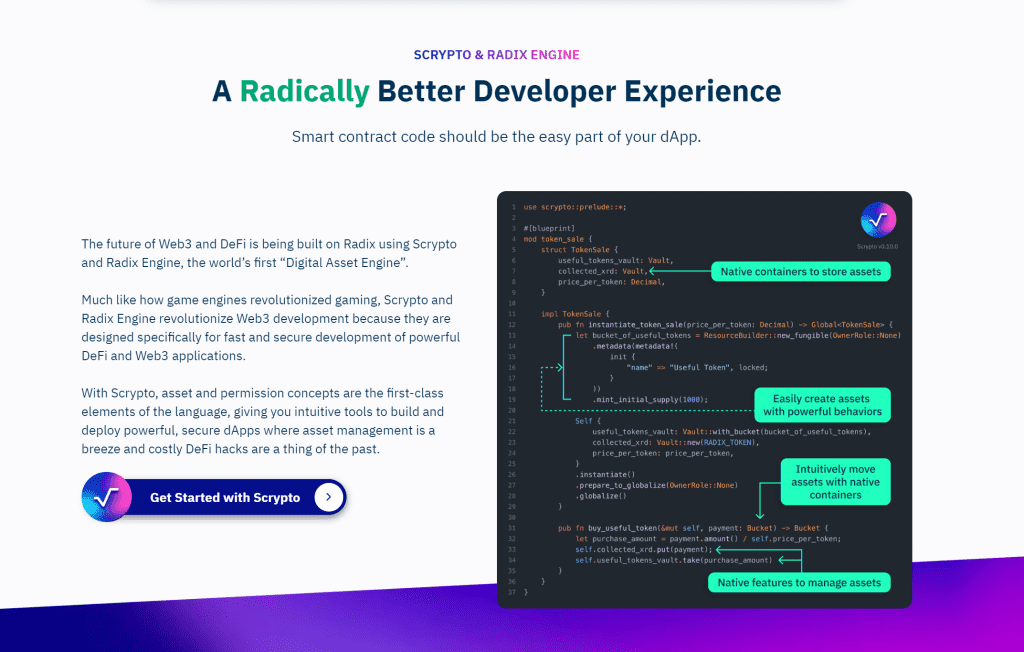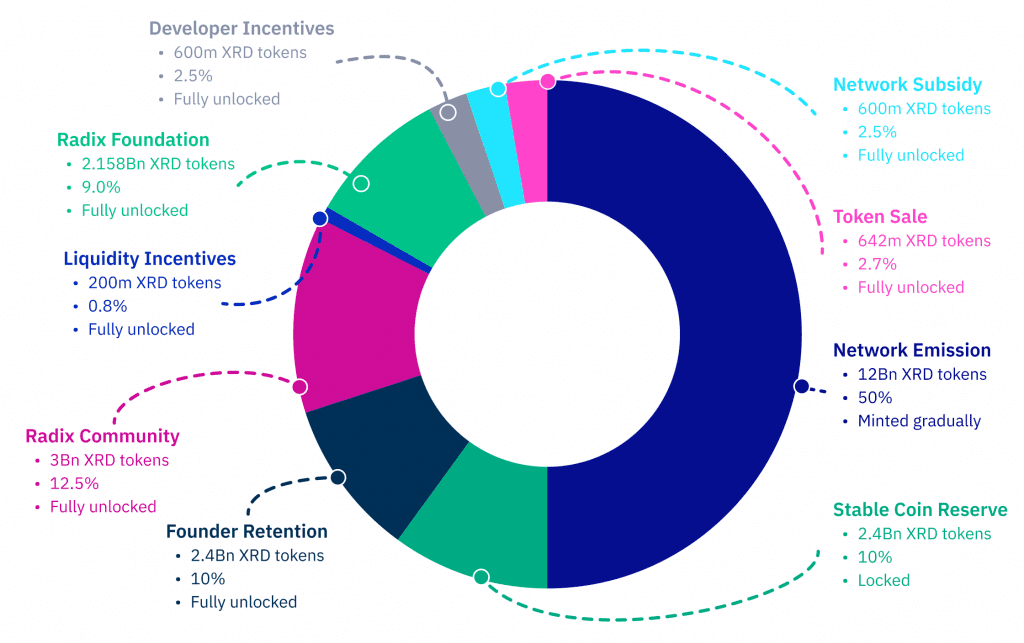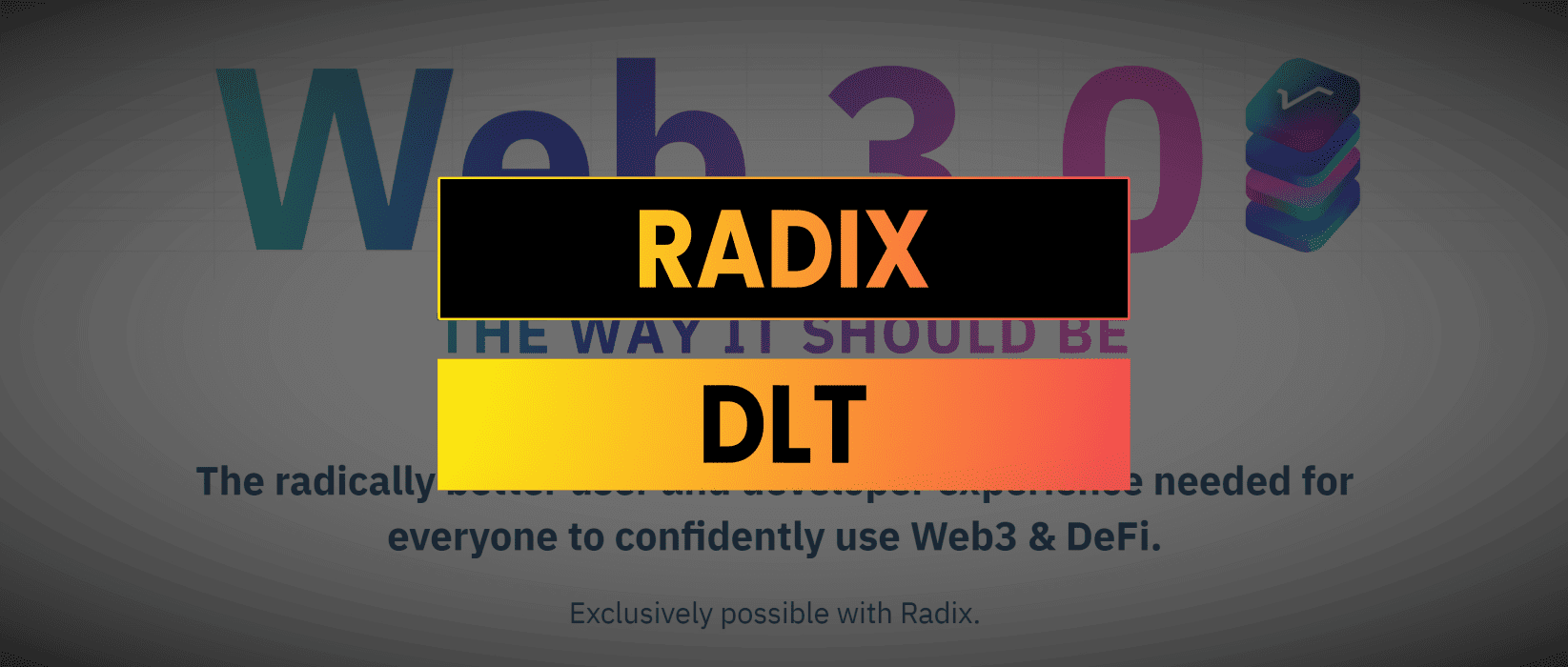Radix is a layer one blockchain which has recently gone live on mainnet enabling developers to deploy scrypto smart contracts. In this report I’ll explore the novelties of the technology, dive into the scrypto programming language, look at the excellent developer resources, analyze the tokenomics of the native XRD token and draw a conclusion on the projects merits.
This is a write up of my internal research notes, this is not a sponsored post and I do not hold any exposure to XRD at time of writing. Do your own research, not investment advice.
What Is Radix DLT
Radix utilizes a delegated proof of stake consensus algorithm that enables “limitless scalability” without violating the composable nature of applications.
The project was founded by Dan Hughes in 2013 (originally named eMunie) and has evolved to become a novel layer one smart contract enabled blockchain. The Radix network is secured by a unique Cerberus consensus mechanism, which allows for both synchronous and asynchronous consensus across a sharded network.
Radix employs a logic system that is akin to those used in critical mission systems such as nuclear power plants that deliver robust and secure outcomes.
To incentivize developers Radix has established a native royalty system which rewards the creation of reusable components and blueprints. This system allows developers to earn usage fees every time their blueprint or component is used in a transaction.
Gas fees are paid in XRD but priced in USD terms to prevent large swings in cost of execution. 50% of the transactional fee is burnt and 50% is distributed as a reward to validators.
The network is accessed via a Gateway, which I believe is similar to an RPC node, and Gateway SDK which can connect a frontend or backend to the decentralized network.

Scrypto Smart Contracts
Scrypto smart contracts are based on Rust and are separated into two parts
- Blueprints – are similar to a class
- Components – are similar to an object within a class
So what we would generally refer to as a smart contract would be a blueprint which contains a collection of components.
Emphasis is laid on writing modular blueprints that carry out a single action efficiently, thereby encouraging the reuse of code.
The language is asset focused, where as in Solidity you would have a token contract which would include any necessary custom functionality, in Scrypto you would have a native asset and any additional functionality would be separated off.

Assets can be created, swapped, transferred all within the native programming language.
Developer Documentation
I was very impressed by the quality and quantity of the developer documentation.
There is the classic HelloWorld tutorial: https://docs.radixdlt.com/docs/hello-token-explained
There is also a Scrypto 101 course which takes roughly 20 hours and they’ll pay you $75 to complete it: https://academy.radixdlt.com/course/scrypto101
There are also tutorials on how to setup a node: https://docs-babylon.radixdlt.com/main/node-and-gateway/node-introduction.html
Reading through this did raise one eye opening remark: “A Validator Node starts life as a Full Node, but has also “registered” itself to the network as a Validator by submitting a special transaction from its account. Registration means that it may now accept XRD token “stake” and potentially be included in the validator set of 100 nodes that conduct network consensus.”
This sounds like the initial nodes with the ability to write to the blockchain is limited to 100 and you probably can’t run one in practice. Optimistically this may be just the training wheels stage since the network has only recently been deployed.
There is also a grants program which is apparently influenced by Y combinator and offers developers $30,000 to build on Radix, note that one of the requirements is the registration of a real business and attendance of a weekly program session.
XRD Tokenomics
The native XRD token is down over 90% since it’s peak in November 2021 and is now trading at $0.058
The project currently has a market cap of $600m and a fully diluted market cap of $1.4B
The distribution looks like this:

50% of the supply is minted over a 40 year period at a rate of around 300m a year which the Radix protocol will use for incentives to node runners through the dPoS system.
Chicken & The Egg
I think it’s fair to say that Radix currently doesn’t have a widely used DeFi ecosystem. There is a chicken and egg problem here which isn’t unique to Radix. To attract developers you need users, people already on-boarded to your layer one blockchain and looking for new projects. To get users you need a killer app.
For Base (Coinbase’s alternate layer one blockchain) they achieved this with the Friend.Tech dApp which I’ve spoken about previously. The challenge for Radix is who is going to build and promote that killer app?
This is obviously a long term project and the technology is pretty impressive in my opinion. The documentation and developer environment is novel and well put together. They need users to attract developers, which will in turn attract more users. However there needs to be a spark to kick off this flywheel.
Because the platform is not EVM compatible it isn’t compatible with Metamask and other wallets creating more friction to onboarding crypto native users. Because the environment is not Solidity based it takes more effort for developers to learn a new smart contract protocol.
Radix has created incentives in terms of royalties, grants and training courses but this is unlikely to attract the type of devs that are really capable of building the next generation of game changing DeFi products in my opinion.
Scrypto has enabled coding beginners to develop working dApps in just a few months. Experienced developers can easily jump in. Compared to Solidity, Scrypto is even more efficient and secure. Those who are “capable of building the next generation of game-changing DeFi products” are not always those who are already known as such. The “killer app” you mentioned may not necessarily be the brainchild of a prior Solidity developer
Insightful counter argument by @Jonas_dph
Radix needs users and they need that killer app for this to gain traction.


